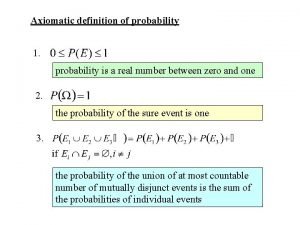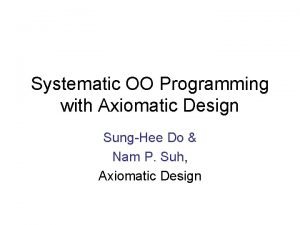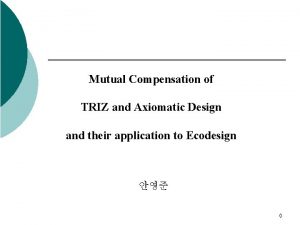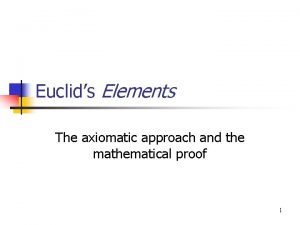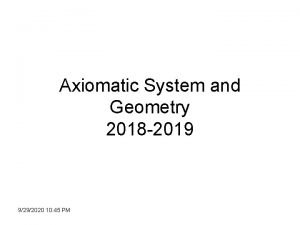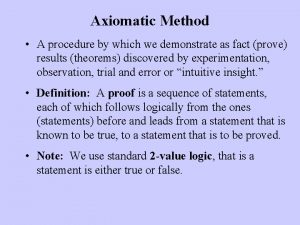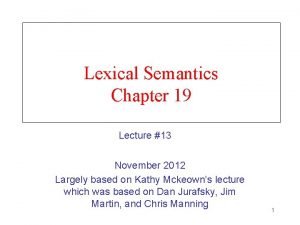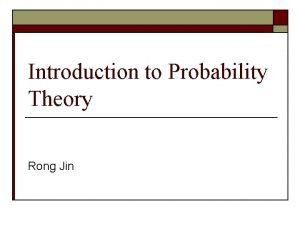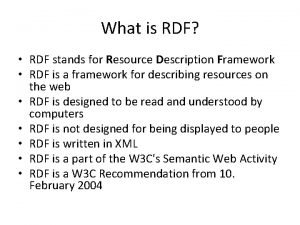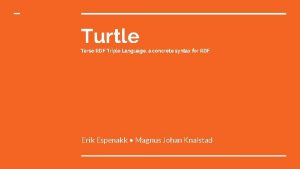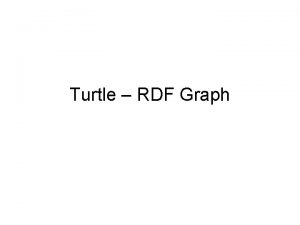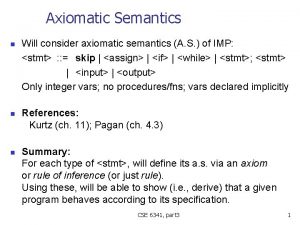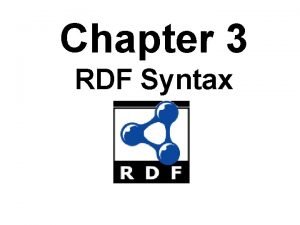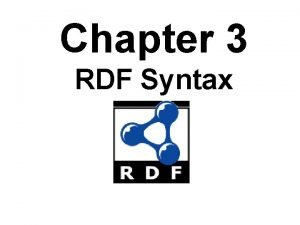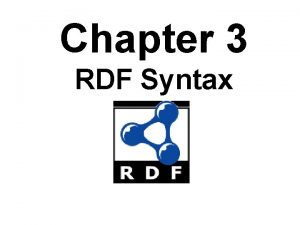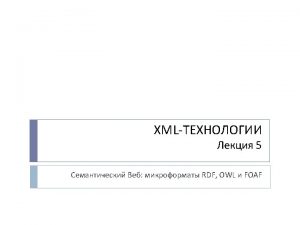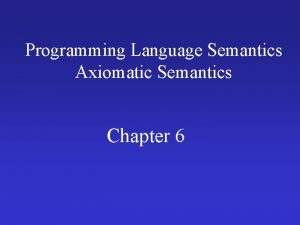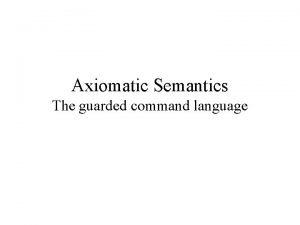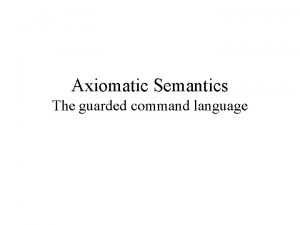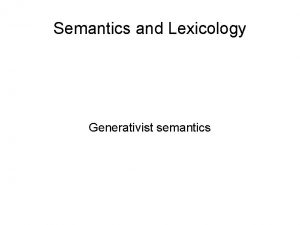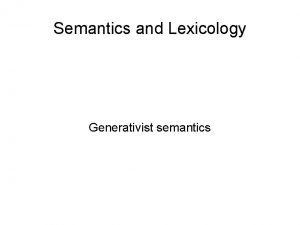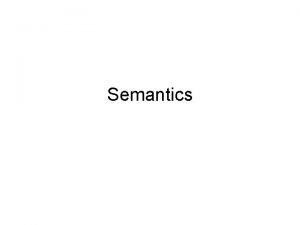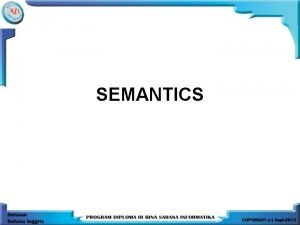An Axiomatic Semantics for RDF RDFSchema and DAMLOIL



![RDF Classes and Properties Classes [10] (18 axioms) Properties [6] (12 axioms) Resource type RDF Classes and Properties Classes [10] (18 axioms) Properties [6] (12 axioms) Resource type](https://slidetodoc.com/presentation_image_h2/ddd047887d5c7c9d06b7fb8515a5cef9/image-4.jpg)
![RDF Schema Classes and Properties Classes [2] (2 axioms) Constraint. Resource Constraint. Property Properties RDF Schema Classes and Properties Classes [2] (2 axioms) Constraint. Resource Constraint. Property Properties](https://slidetodoc.com/presentation_image_h2/ddd047887d5c7c9d06b7fb8515a5cef9/image-5.jpg)









- Slides: 14

An Axiomatic Semantics for RDF, RDF-Schema, and DAML+OIL Richard Fikes Deborah Mc. Guinness Knowledge Systems Laboratory Stanford University www. ksl. stanford. edu 2/12/01 1 Knowledge Systems Laboratory, Stanford University

What’s Inferable From Semantic Markup u Formal specification of intended meaning of semantic markup 4 RDF, RDF Schema, and DAML+OIL u Translation of semantic markup into first order logic (FOL) 4 Produces a logically equivalent ontology in FOL 4 FOL language is KIF (Knowledge Interchange Format) u Provides axioms that specify legal inferences and constraints [137] u Facilitates query answering and constraint checking 4 By traditional theorem provers and problem solvers 4 Provides specs for special purpose reasoners u 2 Provides basis for discussing language changes and extensions Knowledge Systems Laboratory, Stanford University

Translation Method 4 Translate markup into RDF statements I. e. , into “Property P of resource R has value V” E. g. , “Property parent of resource Joe has value John” 4 Translate each RDF statement into a FOL sentence I. e. , into “(Property. Value P R V)” E. g. , “(Property. Value parent Joe John)” 4 Simplify property typing sentences using relation type I. e. , simplify “(Property. Value type R V)” to “(type R V)” E. g. , simplify “(Property. Value type Joe Person)” to “(type Joe Person)” 4 3 Add axioms from the semantics document Knowledge Systems Laboratory, Stanford University
![RDF Classes and Properties Classes 10 18 axioms Properties 6 12 axioms Resource type RDF Classes and Properties Classes [10] (18 axioms) Properties [6] (12 axioms) Resource type](https://slidetodoc.com/presentation_image_h2/ddd047887d5c7c9d06b7fb8515a5cef9/image-4.jpg)
RDF Classes and Properties Classes [10] (18 axioms) Properties [6] (12 axioms) Resource type Property subject Class predicate Literal object Statement value Container _1, _2, _3, … Bag Seq Alt Container. Membership. Property 4 Knowledge Systems Laboratory, Stanford University
![RDF Schema Classes and Properties Classes 2 2 axioms Constraint Resource Constraint Property Properties RDF Schema Classes and Properties Classes [2] (2 axioms) Constraint. Resource Constraint. Property Properties](https://slidetodoc.com/presentation_image_h2/ddd047887d5c7c9d06b7fb8515a5cef9/image-5.jpg)
RDF Schema Classes and Properties Classes [2] (2 axioms) Constraint. Resource Constraint. Property Properties [8] (18 axioms) sub. Class. Of sub. Property. Of see. Also is. Defined. By comment label range domain 5 Knowledge Systems Laboratory, Stanford University

DAML+OIL Classes Thing Nothing Disjoint Restriction Non. Negative. Integer Transitive. Property Unique. Property Unambiguous. Property List Ontology (10 classes; 14 axioms) 6 Knowledge Systems Laboratory, Stanford University

DAML+OIL Properties equivalent. To on. Property max. Cardinality. Q same. Class. As to. Class cardinality. Q same. Property. As has. Value inverse. Of disjoint. With has. Class first union. Of min. Cardinality rest disjoint. Union. Of max. Cardinality item intersection. Of cardinality version. Info complement. Of has. Class. Q imports one. Of min. Cardinality. Q (26 properties; 69 axioms) 7 Knowledge Systems Laboratory, Stanford University

Class Person and Person Joe u Persons are animals and a person’s parents are persons <rdfs: Class rdf: ID = "Person"> <rdfs: sub. Class. Of rdf: resource = "#Animal” /> <restricted. By> <Restriction> <on. Property resource = "#parent” /> <to. Class resource = "#Person” /> </Restriction> </restricted. By> </Class> u Joe is a person one of whose parents is John <Person ID = "Joe"> <parent resource = "#John” /> </Person> 8 Knowledge Systems Laboratory, Stanford University

Translation Into RDF Statements u Persons are animals (type Person Class) (sub. Class. Of Person Animal) u A person’s parents are persons (type R Restriction) (restricted. By Person R) (on. Property R parent) (to. Class R Person) u Joe is a person one of whose parents is John (type Joe Person) (parent Joe John) 9 Knowledge Systems Laboratory, Stanford University

Translation Into First Order Logic (type Person Class) (Type Person Class) (sub. Class. Of Person Animal) (Property. Value sub. Class. Of Person Animal) (type R Restriction) (Type R Restriction) (restricted. By Person R) (Property. Value restricted. By Person R) (on. Property R parent) (Property. Value on. Property R parent) (to. Class R Person) (Property. Value to. Class R Person) (type Joe Person) (Type Joe Person) (parent Joe John) (Property. Value Parent Joe John) 10 Knowledge Systems Laboratory, Stanford University

Primary Axiom For to. Class u If object R is a value of restricted. By for object C 1, and object P is a value of on. Property for R, and object C 2 is a value of to. Class for R, then for all objects I and V, if I is of type C 1 and V is a value of P for I, then V is type C 2. ” u (=> (and (Property. Value restricted. By ? c 1 ? r) (Property. Value on. Property ? r ? p) (Property. Value to. Class ? r ? c 2)) (forall (? i ? v) (=> (and (Type ? i ? c 1) (Property. Value ? p ? i ? v)) (Type ? v ? c 2)))) 11 Knowledge Systems Laboratory, Stanford University

Is John a Person? u From – 4 (Property. Value restricted. By Person R) 4 (Property. Value on. Property R parent) 4 (Property. Value to. Class R Person) 4 (=> (and (Property. Value restricted. By ? c 1 ? r) (Property. Value on. Property ? r ? p) (Property. Value to. Class ? r ? c 2)) (forall (? i ? v) (=> (and (Type ? i ? c 1) (Property. Value ? p ? i ? v)) (Type ? v ? c 2)))) u Infer – 4 (forall (? i ? v) (=> (and (Type ? i Person) (Property. Value parent ? i ? v)) (Type ? v Person))) 12 Knowledge Systems Laboratory, Stanford University

Is John a Person? u From – 4 (Type Joe Person) 4 (Property. Value Parent Joe John) 4 (forall (? i ? v) (=> (and (Type ? i Person) (Property. Value parent ? i ? v)) (Type ? v Person))) u Infer – 4 (Type John Person) u 13 “Yes”, John is a Person. Knowledge Systems Laboratory, Stanford University

Summary u Formal specification of intended meaning of semantic markup 4 RDF, RDF Schema, and DAML+OIL u Translation of semantic markup into first order logic (FOL) 4 Produces a logically equivalent ontology in KIF u Provides axioms that specify legal inferences and constraints u Facilitates query answering and constraint checking 4 By traditional theorem provers and problem solvers 4 Provides specs for special purpose reasoners u 14 Provides basis for discussing language changes and extensions Knowledge Systems Laboratory, Stanford University
 Compare procedural semantics and declarative semantics.
Compare procedural semantics and declarative semantics. Axiomatic probability definition
Axiomatic probability definition Axiomatic design example
Axiomatic design example Systematic oo
Systematic oo What is an axiomatic system in geometry
What is an axiomatic system in geometry Contradiction
Contradiction The axiomatic method
The axiomatic method Axiomatic system of geometry
Axiomatic system of geometry Additive axiom
Additive axiom Axiomatic antonym
Axiomatic antonym Axiomatic definition of probability
Axiomatic definition of probability Rdf stand for
Rdf stand for Subjekt predikat objekt
Subjekt predikat objekt Rdf turtle example
Rdf turtle example Ontology schema
Ontology schema

